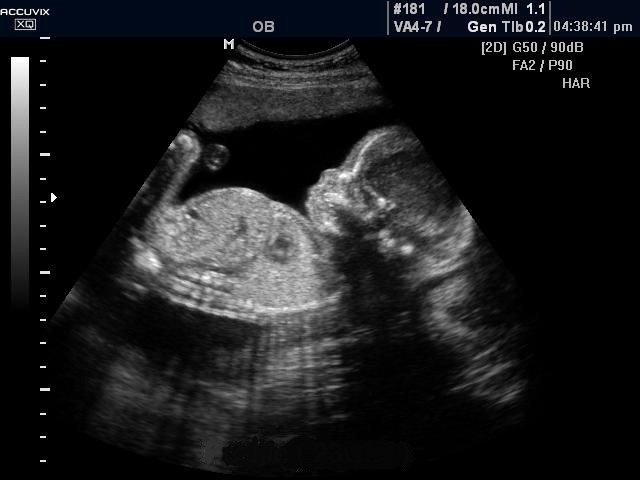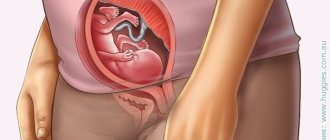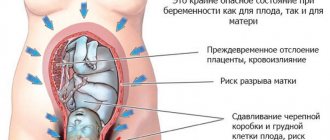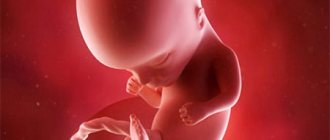Fetal development at 23 weeks of gestation
- Gradually, the baby’s systems and organs begin to perform their assigned functions. By this period, its digestive system is already fully formed. The liver and stomach, pancreas and esophagus, small and large intestines are ready for work.
- If the baby’s brain in the second month of pregnancy weighed only 2 grams, then by the end of the sixth month its weight is about 100 grams! Now mommy needs to walk more and more often in the fresh air, because you need to provide the growing brain of the fetus with enough oxygen.
- From the amniotic fluid swallowed by the child, sugar and water are released, which will later form his original feces - meconium.
- By this stage, the genitals are fully formed. A photo of the fetus performed on an ultrasound scan at 23 weeks of pregnancy can already show exactly who you are expecting.
- By this week of pregnancy, the actively developing and working pancreas synthesizes hormones and insulin.
- At 23 weeks of pregnancy, your baby continues to develop his chest and prepares his respiratory system for further work. Already now the baby is performing up to 60 breathing movements per minute, although he will take his first real breath only after birth.
- All endocrine glands are working, and the child’s spleen is also involved in active work. It constantly produces blood cells, strictly controlling their quality.
- The baby's translucent skin is still wrinkled and covered with vernix. Then subcutaneous fat continues to accumulate.
- The hairs on the child’s body begin to darken.
Fetus at 23 weeks of gestation: movements, development, weight and size
The baby has grown to almost 29 cm and already weighs half a kilo! The brain of the little smart guy is also getting heavier. If in the second month of pregnancy its weight was 2 g, then by the end of the sixth it reaches 100 g. This means that the mother should be in the fresh air as much as possible to ensure the supply of a sufficient amount of oxygen to the baby’s brain.
Walking in the fresh air is also necessary to fully provide the baby with oxygen: the baby will indicate a possible lack of oxygen by increased frequent movements. Yes, yes, the mask is now already announcing its existence in a very tangible way: if a few weeks ago you listened carefully to hear the baby, now he himself is not averse to communicating with his mother through pushes.
For now, the baby’s movements are unobtrusive and do not cause discomfort to the mother, which often happens in the last stages of pregnancy, when the baby, for example, rests its legs on the ribs. But even now, movements may not always occur “on time,” for example, at night, when a woman is trying to rest from a busy day. Is your baby awake and playing in his tummy at night? Try to calm him down by rubbing his belly, humming a lullaby, or telling him a good story.
And during the day, listen to the movements: in half a day, pregnant women usually feel about 10 movements by this time. Remember that the baby has already developed its own sleep and wakefulness pattern: at some moments it may kick, then it calms down for a couple of hours. The complete absence of the child's movements during the day should cause alarm: in such a situation, it is better to immediately consult a doctor.
All organs and systems gradually take over their assigned functions. The baby’s digestive system is fully formed: the stomach, esophagus, large and small intestines, liver, pancreas are ready for work. From the amniotic fluid swallowed by the fetus, water and sugar are separated, which later form the baby's original feces - meconium.
The pancreas is actively working and developing: it synthesizes insulin and other hormones. The genitals of a boy or girl are fully formed. The fetus continues to develop the chest and prepares the respiratory system for work. Although he will take his first breath only after birth, the baby is already making up to 60 breathing movements per minute.
All endocrine glands are actively working, and the spleen is also involved. It not only produces blood cells, but also strictly controls their quality: all “defective” lymphocytes are destroyed.
Subcutaneous fat continues to accumulate, but the translucent skin of the fruit is still wrinkled. And everything is covered with vernix. The hair on the baby's body begins to darken.
You already quite clearly feel the tremors from within and can even feel when the child hiccups: your stomach shakes rhythmically.
Future mom
Of course, during this period you may well experience a lot of “side effects” of pregnancy that bring little joy to the expectant mother: heartburn, constipation, bloating, hemorrhoids, varicose veins, swelling, cramps... Read the recommendations for each individual case.
Don’t be embarrassed by the appearance of age spots and excess hair on your body. If this happens, there is no doubt that it is very unpleasant for the woman, but after childbirth everything will go away. As well as the noticeably improved condition of the hair on the head: due to increased blood flow, the skin and hair follicles began to be better nourished and strengthened. The hair that was supposed to fall out during this time will leave your head in bulk in the first months after childbirth.
And while you may be enjoying your beautiful hair, you are likely to experience problems with your teeth or skin. Pregnancy progresses, the baby takes on a significant portion of calcium and other substances. Don’t let dental problems get worse and contact your dentist on time. Practice daily hygiene; increased sweating may cause you to shower more often. Don't forget about preventing stretch marks.
Of course, eat right, move a lot, get enough rest and enjoy this blessed time: it is slowly coming to an end.
About the baby's movements
At this stage, the mother feels the baby’s kicks quite clearly. You will even feel the moment when the baby begins to hiccup, and at this time your stomach shudders rhythmically. Take walks in the fresh air more often so that your baby is fully provided with oxygen.
With a lack of oxygen, the fetus at the 23rd week of pregnancy begins to move vigorously and frequently.
If the baby decides to frolic at night, when mommy needs to rest, you can calm him down by stroking his belly and quietly humming a lullaby.
Listen to the movements. If there are no active movements of the baby during the day, go to the doctor for a consultation.
Content
- Introduction
- 23rd week of pregnancy: How it feels
- Problems and threats at 23 weeks of pregnancy
- Vaginal discharge at 23 weeks of pregnancy
- 23rd week of pregnancy: Fetal development
- Fetal movements at 23 weeks of pregnancy
- 23 week of pregnancy: Research and analysis
- Ultrasound at twenty-three weeks
- Nutrition at 23 weeks of pregnancy
- Vitamins at 23 weeks of pregnancy
- 23rd week of pregnancy: Physical activity
- 23rd week of pregnancy: Recommendations from gynecologists
- Sex at 23 weeks pregnant
- Conclusion
Height and weight of the unborn child
By this time, your child has not only become more active, but has also grown a lot. At 23 weeks of pregnancy, the weight of the fetus is about 500 grams, and its height reaches 30 cm!

At 23 weeks of pregnancy, it is important not only to eat healthy and balanced, but also to walk more in the fresh air and get proper rest. Enjoy life, enjoy this time.
Many mothers take photographs of their bellies as a keepsake of this period, at 23 weeks of pregnancy. Try to take a photo of your belly when you are 23 weeks pregnant. Believe me, such pictures bring a woman a lot of positive emotions.
Don’t be embarrassed by the appearance of excess hair or age spots on your body. Even if you had a similar problem, after childbirth your hormonal levels will normalize and everything will go away by itself.
The baby grows and takes a significant portion of nutrients and calcium from you for its development. Now a pregnant woman may have problems with her skin and teeth. During this period, you should not start problems with teeth. The expectant mother needs to contact the dentist on time.
Your hormones are still actively working, and sweating increases. Pay attention to maintaining daily hygiene. Be sure to continue to carry out procedures aimed at preventing stretch marks.
Changes in a woman’s body at 23 weeks of pregnancy
Significant hormonal and physiological changes usually do not occur at this time. Well, besides the fact that the tummy grows due to an increase in the weight of the fetus and the size of the uterus. The body of a pregnant woman becomes more rounded, even among those who were not particularly overweight before pregnancy.
It becomes harder to walk, the gait changes, severe shortness of breath, heartburn, and dizziness may appear. All this is due to the fact that the body cannot yet fully carry out the loads that a woman is accustomed to in normal everyday life. Therefore, you should take care and not overexert yourself. After all, your body is now working on only one task - to bear a child and prepare for the birth process.
All unpleasant factors and sensations can be reduced if you follow the instructions and recommendations of doctors. Usually, nutritional correction, comfortable clothes and shoes, and wearing a special support bandage help optimally.
Woman's feelings at 23 weeks
The period of pregnancy has approached, when the expectant mother may well experience a lot of unpleasant symptoms accompanying her condition. This may include constipation, heartburn, hemorrhoids, swelling, bloating, and night cramps in the calf muscles.

Many expectant mothers, when the 23rd week of pregnancy arrives, have stomach, back and lumbar pain. The appearance of such painful sensations is often explained by a shift in the center of gravity due to your growing belly.
Using a prenatal bandage will help alleviate your condition and reduce back and abdominal pain.
The occurrence of cramps in the calf muscles is caused by tired legs and a lack of calcium in the body of the expectant mother. Daily evening foot massages and enriching your diet with calcium-containing foods will help reduce the risk of cramps.
Feelings of the expectant mother at 23 weeks of pregnancy
23rd week of pregnancy.
The obstetric period differs slightly from the embryonic age - literally by 1-2 weeks. At this stage, almost all pregnant women say that this is the easiest and most pleasant period. I feel good, toxicosis no longer manifests itself at week 23, even if it was severe at the beginning of pregnancy. And although the body continues to actively prepare for the upcoming birth, the woman practically does not feel it. Changes are felt more in appearance. For many people, their skin condition improves, their hair seems to become thicker, shiny and silky. It seems that the expectant mother is simply glowing from within.
Of course, you shouldn’t forget about taking care of your body and your baby, even in such an easy period: watch your diet, don’t neglect walks in the fresh air and moderate physical activity, avoid stress and overwork.
Now the woman can already fully feel the movements of her baby. Sometimes the baby can be very active, and the mother can feel quite unpleasant sensations if the fetus kicks him in the ribs or in the bladder.
At this time, be sure to start communicating with the unborn baby: talking, stroking the belly, singing lullabies or telling fairy tales. The embryo already hears well, reacts to sounds and bright light, to touch. It is very important to establish close contact between mother and child now.
It is worth knowing that in the 23rd week some strange and unpleasant symptoms may appear and it is important to understand when you should worry and when not. For example, severe and frequent heartburn during this period is a completely normal and common occurrence. The fact is that the uterus has grown so much that it strongly compresses the internal organs, including the entire gastrointestinal tract. You should not rush to solve this problem with the help of medications. For mild symptoms of heartburn, dietary correction (eating small meals), as well as milk and chocolate in small quantities, helps.
What is unpleasant at this stage and a problem for, perhaps, all pregnant women is the frequent urge to urinate. Now the fetus puts a lot of pressure on the bladder, so the urge is frequent and strong. There’s nothing you can do about it: before traveling, try not to drink a lot of liquid, just like before going to bed. Then these symptoms will not appear so strongly.
Some pregnant women experience red hands. There is no need to be afraid - this is due to hormonal changes in the body. Sometimes the hands may become numb.
And what is definitely worth mentioning are training contractions or, as they are also called, Braxton-Hicks contractions. Already at the twenty-third week, a pregnant woman begins to feel slight cramps in the lower abdomen. They are not painful, but may cause anxiety. Don't worry - this is how the uterus prepares for the upcoming birth and contracts.
Many women report severe pelvic pain. This is also a harmless, but rather unpleasant factor - the pelvic bones begin to diverge, so that in the future the woman in labor will be able to push the fetus through the natural method of childbirth.
The belly is already very noticeable this week. The figure becomes rounded and the gait becomes duck-like.
The breasts have increased significantly in size. There may be a small discharge of clear liquid - colostrum.
0 0 vote
Article Rating
What happens to the stomach
Pain on the sides of the abdomen is often explained by stretched ligaments that support the growing uterus.
During this period, painless training contractions may appear. If such contractions become frequent and painful, and amniotic fluid is noticeably leaking, call an ambulance immediately, most likely you are going into premature labor.
Sometimes constipation can cause abdominal pain. In this case, you should include in your menu foods rich in fiber and foods that have a mild laxative effect.
Belly at 23 weeks of pregnancy: tugs, hurts
But from time to time they can cause painful sensations in the abdominal area. Often the expectant mother at this stage complains of pain in the abdomen, in particular on the sides, especially when she gets up, sneezes, or coughs. This is due to overstretching of the muscles that support the uterus.
Also from this period you may feel false training contractions. Braxton-Hicks contractions are a completely normal phenomenon for the second half of pregnancy: in this way, the uterus seems to be warming up before the upcoming, and already real, birth. Training contractions are episodic uterine spasms that should not cause the woman any pain. If contractions become regular, painful, and are also accompanied by rupture of amniotic fluid, call an ambulance immediately: you are experiencing premature labor.
Abdominal pain can be caused by constipation and the inability to have bowel movements normally. In this case, it is rational to review the diet and include in the menu foods that are rich in fiber and have a laxative effect.
And keep in mind: if abdominal pain is accompanied by additional symptoms (such as fever, bloody vaginal discharge, etc.), then you should immediately consult a doctor.
The nature of discharge at 23 weeks of pregnancy
The twenty-third week of pregnancy begins, which is characterized by the following vaginal discharge:
- transparent or light milky color,
- liquid consistency,
- without obvious pronounced odors.
The appearance of greenish, yellow or gray discharge, bubbling, purulent or curdled, with an unpleasant odor, accompanied by itching and burning in the perineal area indicates the possibility of an infectious disease. In this case, you need to rush to the doctor immediately. You will have mandatory treatment to help avoid intrauterine infection of the baby.
Also, if brown or bloody discharge appears, accompanied by cramping pain in the abdomen, you should rush to see a doctor.
Similar symptoms are characteristic of uterine hypertonicity, placental abruption or placental previa.
The appearance of heavy bleeding against the background of constant contractions indicates the onset of premature labor. If brown spotting is painless and appears only after a gynecological examination or sexual intercourse (when sex is not contraindicated for you at 23 weeks of pregnancy), then most often it is associated with cervical erosion.
In any case, consulting a specialist will not hurt.
Discharge detection
At the 23rd week of pregnancy, there is discharge of both milky and transparent colors. If the mucus compartments have no odor, then this is considered normal. Doctors inform patients that in the twenty-third week of pregnancy, the formation of vaginal compartments always occurs. Natural and non-pathological discharge of mucus from the vagina is characterized by a transparent color, and the woman’s discharge should be liquid.
The formation of green and purulent discharge with the presence of foreign odors, as well as the manifestation of itching and burning in the perineum, means that the pregnant woman has an infection in the reproductive system. Such concomitant phenomena require the help of a physician, otherwise it can lead to serious consequences. The doctor prescribes the necessary therapy, thanks to which it will be possible to stop the pathological process and protect the fetus from infection.
The occurrence of heavy bleeding along with contractions indicates that the woman has begun premature labor. The appearance of brown spotting from the genitals of a painless nature, formed after a gynecological examination, means that the pregnant woman has erosion in the cervix. If such manifestations occur, you should consult your doctor (gynecologist).
Abundant discharge from the vagina with the appearance of foam and a dark color indicates that an inflammatory process has occurred in the genital structure. With this form of damage, immediate treatment with antimicrobial and anti-inflammatory drugs is necessary, since in the absence of therapeutic effects, infection will occur in the placenta, amniotic fluid, and the disorder will harm the development of the fetus.
In gynecological practice, it has been recorded that the most common reason for deciding to terminate a pregnancy at any stage is the addition of a bacterial infection. Transparent mucous secretions require a special test to determine the exact cause of the formation. Bloody discharge at the 23rd week of pregnancy occurs both as an independent manifestation and with the addition of pain. The most important thing is to pay attention to the formation of symptomatic signs and take all necessary measures.
What can be seen on an ultrasound
During this period, the main task of the examination is to diagnose the condition of the baby and his mother. An ultrasound shows 23 weeks of pregnancy, if the baby is successfully unwrapped, parents can already find out exactly who they are expecting.
During an ultrasound, the doctor assesses the size of the baby and its correspondence to the gestational age, listens to the heartbeat and notes the baby’s motor activity, and examines the internal organs of the fetus. These studies are necessary to rule out abnormalities and developmental defects in your child.
You can also ask your doctor to take an ultrasound photo of your 23rd week of pregnancy for you as a souvenir. Among other things, the doctor assesses the size and condition of the uterus, the amount of amniotic fluid, and looks at the location of the placenta.
What happens to the baby at 23 weeks of pregnancy
The size of the fruit already reaches 29 centimeters, and its weight is about 500 grams. Your baby is the size of an eggplant
The child’s respiratory system is now actively developing. Although the baby's lungs are not yet expanded, he regularly exercises and does breathing movements in preparation for the moment of birth. The blood vessels in your baby's lungs continue to develop so that your baby can breathe after birth.
The baby's eyes are already open, he distinguishes between light and darkness, and reacts to them by changing his behavior. His hearing is already quite well developed, and he can distinguish between your voice, the beating of your heart and the rumbling in your stomach. The digestive system is ready to perform its functions, the child constantly swallows amniotic fluid, the liquid part of which is broken down into sugar and water and absorbed in the intestines, and scales and vellus hairs caught with the water form meconium, which is excreted after childbirth.
Nutrients are intensively supplied by the placenta, and this significantly increases the circulation of maternal blood. This stage of fetal development is determined by the development of the endocrine and nervous systems, which contributes to its accelerated development in all directions. All glands function almost at full capacity, which allows the child’s body to partially abandon maternal dependence.
At week 23, the baby continues to accumulate subcutaneous fat, he is rounded, takes on a more familiar appearance to the eye, however, for now he still looks like a small, wrinkled red man. Due to the accumulated pigments, the skin ceases to be transparent.
The baby continues to swallow small amounts of amniotic fluid. At week 23, the baby can swallow up to 500 ml. It removes it from the body in the form of urine. Since the amniotic fluid contains epidermal scales, particles of protective lubricant, and vellus hair, the child periodically swallows them along with the water. The liquid portion of the amniotic fluid is absorbed into the blood, leaving a dark olive-colored substance called meconium in the intestines. Meconium forms from the second half of pregnancy, but is normally released only after birth.
Where does ARVI come from?
It's no secret that ARVI is a complex name for numerous infectious diseases that are caused by viruses and bacteria. Often, an infection can be contracted from another person, either through airborne droplets or through the use of household items (towel, clothing, dishes, etc.).

Often, a respiratory viral infection can be contracted through airborne droplets.
That is why pregnant women can be given the following recommendations to help prevent the disease:
- Limit communication with strangers on the street, at work, on public transport, especially during a flu epidemic.
- Wear a medical bandage if you are going to visit a clinic, where there are already quite a lot of people with ARVI, influenza and other infections.
- Do not take other people's household items.
- After going outside, be sure to wash your hands with soap.
- If you were near a person who coughed or sneezed, you should take measures to prevent ARVI so that the germs do not have time to spread inside the body.
We also recommend: ARVI during pregnancy
Weight gain at 23 weeks of pregnancy
Throughout the entire period of bearing the baby, the expectant mother needs to gain no more than 10 - 12 kilograms. In the first trimester, the expectant mother begins to recover, starting from the third month. This affects both early toxicosis and the body’s adaptation to the new status. On average this is one to two kilograms. The intensity of gain in the second trimester begins to increase and is recommended within 250 - 300 grams. in Week. At 23 weeks of pregnancy, a woman can gain up to 8 kg (from the beginning of pregnancy), while the fetus weighs about 500 grams.
Analyzes and examinations
What examinations can a pregnant woman expect at 23 weeks? As a rule, only a urine test. However, according to indications, others may be prescribed.
Ultrasound at 23 weeks of pregnancy
The expectant mother should have undergone a planned ultrasound scan of the second trimester when the second screening was carried out (from the 19th week). However, if for some reason the study was missed, it must be done. This is necessary for the timely detection of pathologies in the baby’s development.
If the screening was carried out in a timely manner, there is no need for an ultrasound scan at this time.
Progesterone norm
Typically, a progesterone test is not taken at 23 weeks, but it may be required if:
- carrying an IVF baby;
- threat of premature birth;
- fetal pathologies;
- the need to measure the hormonal levels of the expectant mother.
Normally, this figure is from 59 to 78 nanograms per liter.
Is ultrasound at 23 weeks harmful?

Gynecologists around the world do not deny the fact that ultrasound can harm the baby in the very early stages, from five to eight weeks. Especially when it comes to transvaginal ultrasound. But after the twentieth week, the fetus is already strong enough and developed, like the placenta, so that ultrasonic waves do not negatively affect their condition. In addition, modern medicine uses the latest generation of devices that act very gently. The harm from ultrasound examination has not been documented, but its benefits are significant. This also concerns the early detection of malformations of the fetus and placenta, when there is time to eliminate negative factors before birth.











